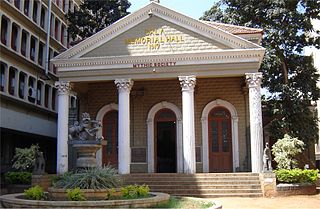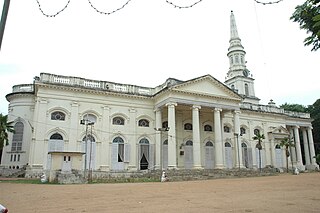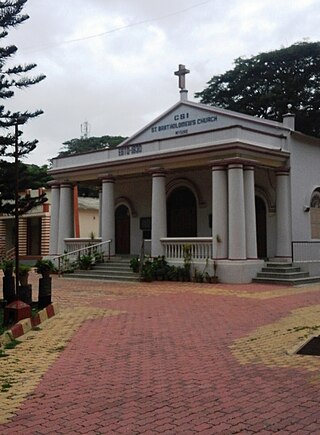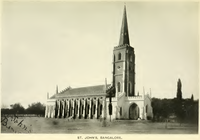The Bangalore Cantonment (1806–1881) was a military cantonment of the British Raj based in the Indian city of Bangalore. The cantonment covered an area of 13 square miles (34 km2), extending from the Residency on the west to Binnamangala on the east and from the Tanneries on Tannery Road in the north to AGRAM in the south. By area, it was the largest British military cantonment in South India. The British garrison stationed in the cantonment included three artillery batteries, and regiments of the cavalry, infantry, sappers, miners, mounted infantry, supply and transport corps and the Bangalore Rifle Volunteers. The Bangalore Cantonment was directly under the administration of the British Raj, while Bangalore City itself was under the jurisdiction of the Durbar of the Kingdom of Mysore.

The Daly Memorial Hall, is a heritage building located in Bangalore, Karnataka that houses the Mythic Society. The Mythic society, founded in 1909, is a pioneering institution of Catholic-Indic studies in South India. Daly Memorial Hall, built at a cost of INR 24,783, was inaugurated on 25 July 1917 by the Kanteerava Narasimharaja Wadiyar (the Yuvaraja of Mysore. The Hall is named after Sir Hugh Daly, who served as the Resident of Mysore State and Chief Commissioner of Coorg.

St. George's Cathedral is a Church of South India cathedral in Chennai, India. The cathedral was built in 1815. St. George's occupies an important place in the history of Christianity in India, as the Church of South India was inaugurated here on 27 September 1947. It marked the breaking down of ecclesiastical barriers between Protestants of various traditions.
The Karnataka Central Diocese is one of the twenty-two dioceses of the Church of South India covering the central part of Karnataka.
Hoysala Nagara, previously known as Murphy Town or Knoxpete, is a suburb located near Bangalore Cantonment, India. It is one of the oldest planned suburbs of the Cantonment, and was earlier known as Knoxpete, and was later changed to Hoysala Nagara. It is located North of Halasuru, with Murphy Road running along its periphery, and is also bounded by Old Madras Road and Kensington Road, with part of Kensington Road overlooking Halasuru Lake Madras Sappers.
Pulakeshi Nagara, previously known as Fraser Town or Mootocherry, is a suburb of Bangalore Cantonment, in Bangalore North-East, adjoining Shivajinagar and Ulsoor spread over 4 km2. It was established in 1906 and is named after Stuart Mitford Fraser (1864–1963), who was the tutor and guardian of Krishna Raja Wadiyar IV, Maharaja of Mysore. Pulakeshi Nagara was established to de-congest the growing Bangalore Civil and Military Station. The foundation of Pulakeshi Nagara was laid in August 1910 by Mrs. F J Richards, with a commemorative plaque on the corner of Coles Road and Mosque Road. Pulakeshi Nagara is a residential and commercial suburb, the prominent roads being Coles Road,Promenade Road, Netaji Road, Madhavraya Mudaliar Road, Haines Road, Spencer Road, Wheeler Road, Mosque Road, etc. The suburb is known for its communal harmony with Hindus, Muslims and Christians living side by side in peace. Before being known as Fraser Town, the suburb was called Mootocherry by the locals. In 1988, the BBMP renamed Fraser Town as Pulakeshi Nagara, after Pulakeshin II who ruled the Deccan in the 7th century.
Sarvagnanagara, previously known as Cox Town is a suburb located North in the Bangalore Cantonment, named after the last Collector and District Magistrate of the Bangalore Civil and Military Station, Alexander Ranken Cox, Indian Civil Services. It is one of the suburbs which came out of the plan to de-congest thickly populated areas of the Bangalore Cantonment after the bubonic plague. Agricultural fields were converted for this purpose, and town was planned according to modern hygienic standards, with drainage and conservancy conveniences. Sarvagnanagara is bound by the Bangalore-Madras Railway line on the North and East, Wheeler Road in the East and the Ulsoor Polo Ground in the South. It consists of posh localities like Heerachand Layout and other localities like Sindhi Colony, Jeevanahalli, Doddigunta, and roads such as Assaye Road, Charles Campbell Road, Wheeler Road, etc. and is adjoining the suburbs of Pulakeshi Nagara, Sri Krishnaraja Wadiyar Nagara and Cooke Town, with easy access to the Bengaluru East Railway Station, Halasuru, Lingarajapura, Shivajinagara. Sarvagnanagara is a well planned, posh and preferred suburb in the Bangalore Cantonment, created during the British Raj. The residents of Sarvagnanagara follow a liberal 'live a let live' attitude, with suburb still retaining much of its green cover, without excessive commercialisation. In 1988, the BBMP renamed Cox Town as Sarvagnanagara, after a 16th-century saint poet.

St. Mark's Cathedral, dedicated to Saint Mark the Evangelist, is the cathedral of the Diocese of Central Karnataka of the Church of South India. The cathedral church, noted for its English Baroque architecture inspired by the 17th century St Paul's Cathedral, is located at the west end of Mahatma Gandhi Road, MacIver Town, Bangalore.
St. Andrew's Church, consecrated in 1866, is a Presbyterian church, located on Cubbon Road, Bangalore. Initially knows as St. Andrews's Kirk, it was a Church of Scotland church till 1959 when it became part of the Karnataka Central Diocese of the Church of South India. The church is named after Saint Andrew, the patron saint of Scotland. St Andrew's Church celebrated its 150 years anniversary on 20 November 2014.

St. Bartholomew's Church is an Anglican church, built by the Madras Government for the East India Company troops stationed in Kingdom of Mysore and is located in Lashkar Mohalla, on the Nilgiri Road, near the noisy Mysore sub-urban bus stand in Mysore City. The church grounds was consecrated on 29 November 1830 by Bishop Turner of Calcutta, (p. 327) and the building was completed in 1832. The church is named after Saint Bartholomew, one of the 12 apostles of Jesus Christ, and is said to have visited India in the first century AD, and preached the Christian gospel in the Kalyan, Thane and Raigad regions of present-day Maharashtra.
St. Paul's Church is located in the corner of Old Poor House Road, and Bowring Hospital Road, next to the Bowring and Lady Curzon Hospital, Bangalore Cantonment, India. St. Paul's has the distinction of being the very first Tamil Anglican Church in the erstwhile Mysore State. St. Paul's celebrated its 175th anniversary in May 2014. Like most old churches of Bangalore, the congregation of St. Paul's is spread all across Bangalore.

The Fort Church, Bangalore, was a church located within Bangalore Fort. The church was demolished to make place for the construction of the Vani Vilas Hospital. The Government of Mysore then allotted land in Chamrajpet for construction of a new church, St. Luke's Church, Bangalore. Early records refer to the Fort Church as the Drummer's Chapel, constructed by British soldiers after the fall of Tippu Sultan. The Fort Church, Bangalore was the first protestant church to be raised in Bangalore.
Goodwill's Girls School is located at Promenade Road, Fraser Town, Bangalore Cantonment. Formerly known as the Wesleyan Tamil School, the school was renamed after Rev. Fred Goodwill, a British Missionary and Tamil scholar, who served as the manager of the school, in his capacity as superintendent of the Wesleyan Tamil Mission, Bangalore and Kolar Gold Fields.
The Rice Memorial Church is located in the busy Avenue Road, Bangalore Pete. It is named after Rev. Benjamin Holt Rice, a missionary of the London Missionary Society (LMS), a Canarese scholar and a pioneer of education in the Bangalore Pete region. The Rice Memorial Church stands on a busy street in the midst of temple, dargahs, book shops and heavy traffic, with its colonial British structure appearing to be out of place in the traditional Bangalore market district. The church stands on the site of the London Mission Canarese Chapel built by Rev. Rice, which itself was built on the site of the first Canarese chapel built by William Campbell in 1834. The church is a stone building in the European Classical style, with Tuscan columns, pediments and keystone arch windows. The church building has been demolished and raised at least 3 times, with the current structure consecrated in 1917.
Cooke Town is a neighbourhood in Bangalore Cantonment, in Bangalore North-East, India. Built as a suburb before Indian Independence, it is one of Bangalore's oldest neighbourhoods, established when the Bangalore Civil and Military Station was governed by the Madras Government. Cooke Town is named after G H Cooke, President of the Bangalore Civil and Military Station Municipality between 1928 and 1934, with the Mayo Hall being constructed during his tenure. The suburb, along with other suburbs of the Bangalore Cantonment such as Pulakeshi Nagara, Sarvagnanagara, Sir Mirza Ismail Nagara, and Langford Town, has seen dynamic changes over last few years with large British Raj era bungalows being demolished to build luxury apartments. These developments have resulted in large-scale tree-felling. However, Cooke Town still manages to retain some of its colonial charm, and is called the nicest place in the Cantonment by Bangalore historian Peter Colaco. Cooke Town is a posh neighbourhood with plenty of greenery, parks, educational institutions, hospitals and is at close proximity to the Bangalore East Railway Station and the Bangalore CBD. According to Colliers International, Cooke Town is one of Bangalore's most costliest neighbourhoods, with the cost of property being in the range to INR 70000-75000 per sq.ft, just slightly lesser than the Bangalore CBD.
The Hudson Memorial Church is located in the Bangalore Pete, Hudson Circle, surrounded by the Office of the Bangalore Corporation, Ulsoor Gate Police Station, Cubbon Park and Kanteerava Stadium. The church was established in 1904, and is a Kannada CSI church of the Bangalore Diocese. The church has around 4000 registered members and is named after Rev. Josiah Hudson, a missionary, Canarese scholar and educationist who started many Canarese schools in the Bangalore Petah region. The church was earlier known as the Wesleyan Mission Canarese Chapel, and was located in Ganikara Street, Nagarathpet, and moved the current location at Hudson Circle and renamed as Hudson Memorial Church in 1904. The church attracts people of all faiths, who visit the church to seek blessing, especially in Thursdays and Sundays.

Thomas Hodson was a Wesleyan Missionary, who served in India, in the Wesleyan Canarese Mission, at the Bangalore Petah and Gubbi. He helped in running the first Wesleyan Mission Canarese school in the erstwhile Mysore State. Hodson was a linguist and a Kannada scholar, and was also fluent in Tamil and Bengali. He helped in establishing the Wesleyan Canarese Chapel at Nagarthpete in the Bangalore Petah. In 1864, Hodson wrote An Elementary Grammar of the Kannada, or Canarese Language, a treatise on the grammar of the Kannada language.
The East Parade Church, consecrated in 1865, is located on Mahatma Gandhi Road, in the Bangalore Cantonment. The church comes under the Karnataka Central Diocese of the Church of South India. Started in the early 19th century as the Wesleyan Mission Chapel by Wesleyan believers of the Madras Army with Tamil and English services, the Church now has services in Tamil and Malayalam. The name East Parade comes from its location on the East of the Parade Grounds of the Madras Engineer Group (MEG) regiment. The present church building was raised in 1865, on the site of the old Wesleyan Mission Chapel, with an inscription dated 6 October 1863 marking the laying of the foundation stone.
The United Mission School is located on Mission Road, Bangalore and is managed by the Church of South India. The school offers English medium education and is affiliated to the Karnataka Secondary Education Examination Board. The school has classes from Year 1 to Year 10. In 1993, the United Mission Degree College was established on the same campus, offering Bachelor of Commerce and Bachelor of Business Management courses, affiliated to the Bangalore University.
Samuel Thomas Pettigrew (1827–1889) was an East India Company chaplain, who served in Rangoon, Kamptee, Bangalore, Ootacamund and Trivandrum, and is credited with establishing the Bishop Cotton's School and Cathedral High School in Bangalore.









